Keep exploring the rich symbolism of farms in the Bible to uncover ancient lessons on life, ethics, and spirituality.
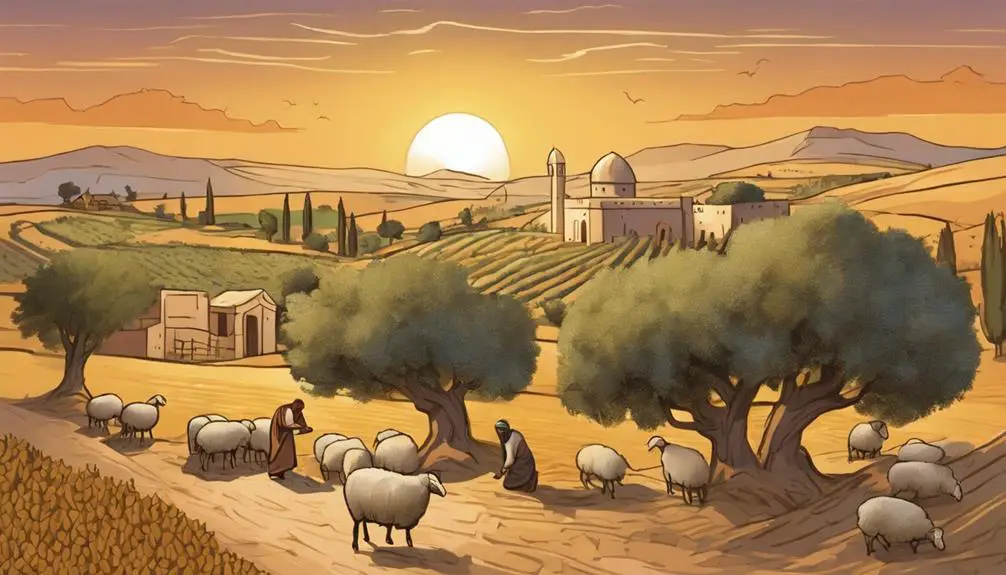
Farms in the Bible
In the tapestry of biblical narratives, farms aren't merely plots of land but fertile grounds sown with lessons and symbols. You'll find that from the Garden of Eden to the parables Jesus taught, agriculture weaves a story of sustenance, ethics, and divine principles.
Exploring these ancient farms offers insights into how our ancestors interacted with the land, celebrated their harvests, and understood their world. This journey could reshape your perception of biblical teachings, revealing layers you might not have considered before.
So, why not explore what these stories have sown for us to harvest?
Key Takeaways
- Biblical agriculture was rooted in sustainability, stewardship, and a profound connection to the divine.
- Farming practices and parables in the Bible convey deep spiritual truths and lessons on growth, faith, and human nature.
- Technological advancements and water management strategies highlight the innovation and resilience of ancient agricultural methods.
- Harvest festivals in biblical times celebrated community unity, gratitude to God, and the cyclical nature of farming and divine provision.
The Garden of Eden: Agriculture's Origin
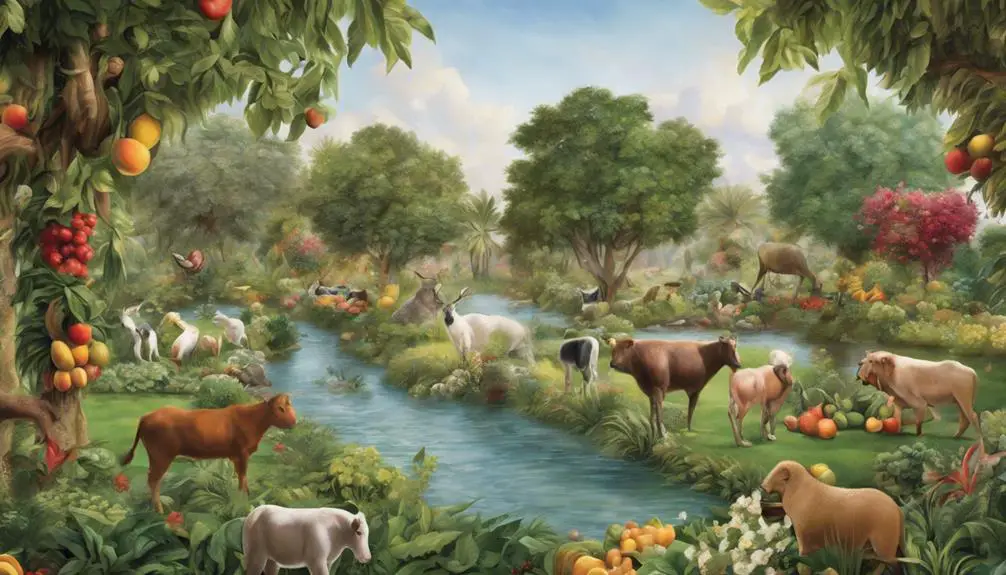
In analyzing the Garden of Eden, it's clear that this biblical narrative introduces the concept of agriculture as humanity's foundational interaction with the land. The text intricately describes Eden's ecology, presenting it as a lush, self-sustaining system where humans and nature coexist harmoniously. This place, often depicted as paradise, is your first glimpse into Divine gardening, a concept where the divine caretaker sets the standard for human agricultural practices.
You'll notice that Eden's design isn't just about beauty or abundance; it's a model for sustainable living. The divine command to tend and keep the garden implies a relationship with the earth that's caretaking rather than exploitative. This is a crucial point, as it sets the stage for how humanity's stewardship of the land is supposed to unfold.
As you delve deeper, it becomes apparent that Eden's ecology isn't just a backdrop for the narrative; it's a character in its own right. It teaches you about biodiversity, the importance of ecological balance, and the role of humans within it. Through this lens, the story of Eden isn't just about beginnings; it's a template for understanding the sacredness of agricultural practices, framing them as acts of divine imitation.
Farming in the Land of Canaan

Moving beyond Eden's paradisiacal provisions, the narrative of agriculture evolves as it enters the complex and varied terrain of the Land of Canaan. Here, you'll find that farming wasn't just about sowing and reaping; it was a sophisticated interplay of knowledge, environment, and innovation.
The Canaanite crops, for instance, weren't merely chosen; they were a testament to the adaptability and agricultural acumen of the Canaanites. Grains like wheat and barley, along with fruits such as grapes and olives, formed the backbone of their diet and economy. These crops demanded not just labor but a deep understanding of the land.
Irrigation methods in Canaan were equally ingenious. With rainfall unpredictable and water sources scarce in some areas, the Canaanites developed techniques that maximized water usage. They built terraces on hillsides to reduce soil erosion and runoff, ensuring that every drop of water was utilized to nourish their crops. Cisterns and storage pits were common, capturing rainwater for the dry seasons.
This strategic approach to agriculture underlines a broader narrative: farming in Canaan was as much about resilience and innovation as it was about tilling the earth.
Parables and Farms in Jesus' Teachings
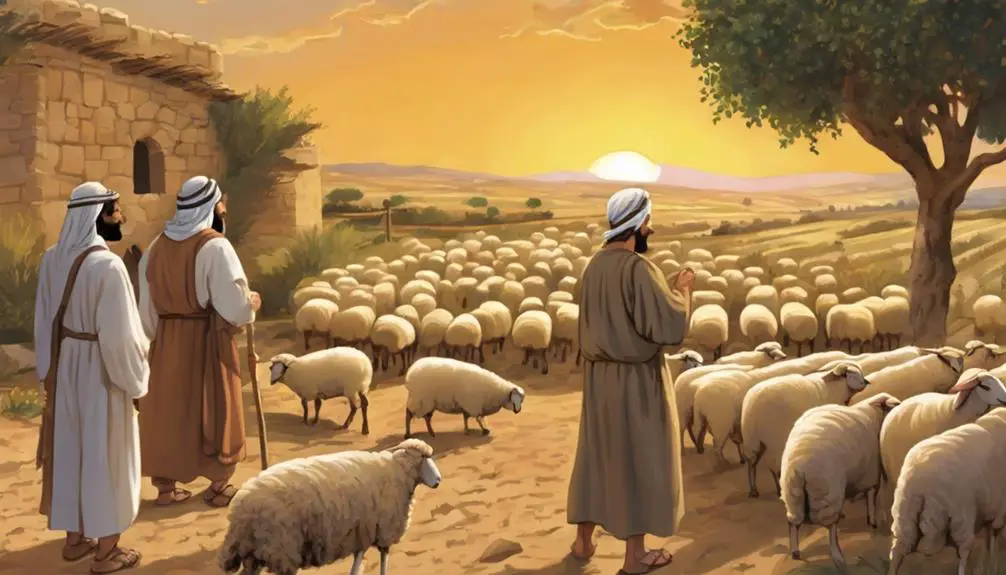
Jesus' teachings often wove the fabric of everyday farming life into parables, highlighting deep spiritual truths through the familiar rhythms of sowing, growing, and harvesting. You'll find that these stories aren't just about agriculture; they're rich with lessons on spiritual growth and the complexities of human nature. Seed symbolism, in particular, stands out as a recurring theme, demonstrating how something small and seemingly insignificant can flourish into something vast and impactful under the right conditions.
- Parable of the Sower: Here, the types of soil represent different responses to the word of God, emphasizing how receptivity is crucial for spiritual growth. It's a call to self-examination and preparation for receiving divine truth.
- Parable of the Mustard Seed: This parable illustrates the kingdom of Heaven as a mustard seed that grows into a large tree. It's a powerful metaphor for how faith, no matter how small, can expand beyond our imagination.
- Parable of the Weeds among the Wheat: It teaches patience and trust in divine judgment, showing that good and evil may coexist until the end of time, challenging us to focus on our growth without being deterred by the negative.
Each of these parables uses the familiar to explain the divine, inviting you to see beyond the physical and into the spiritual realm where faith and actions grow in tandem.
Agricultural Laws and Practices
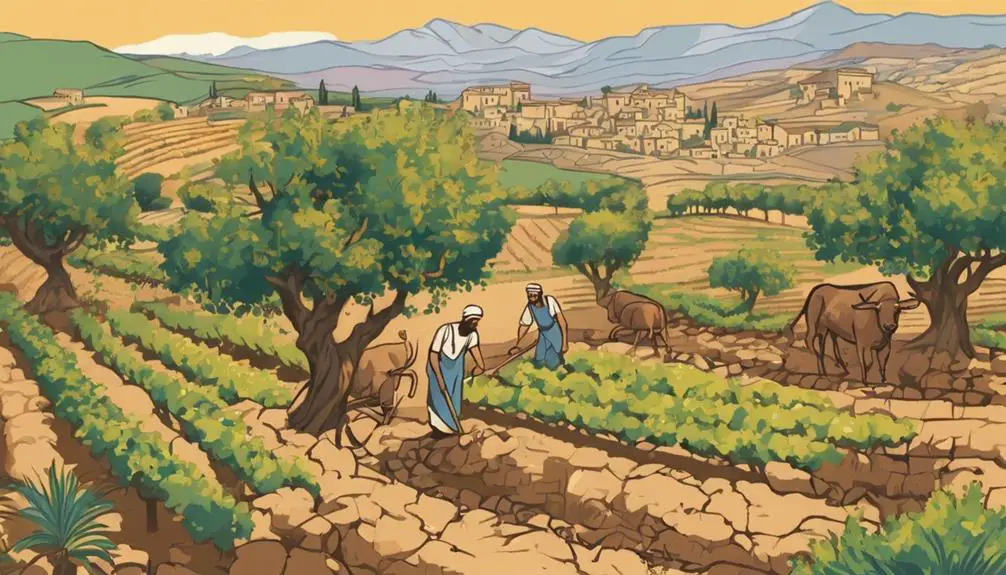
While exploring how farming metaphors illuminate spiritual truths, it's also crucial to understand the historical agricultural laws and practices that shaped daily life in biblical times. You'd find that land ownership wasn't just a matter of economic interest but deeply entwined with identity and heritage. Lands were typically passed down through generations, ensuring that families maintained their ancestral holdings. This perpetuated a sense of stability and continuity within communities, reinforcing social and spiritual connections to the land.
Moreover, the practice of crop rotation played a pivotal role in sustaining the fertility of the soil. You wouldn't find farmers planting the same crop year after year; instead, they'd rotate crops to prevent depleting the soil of necessary nutrients. This method not only maximized agricultural output but also reflected a profound understanding of stewardship of the earth's resources. It's a testament to the wisdom embedded in biblical laws and practices, emphasizing sustainability and care for creation long before these concepts became a global concern.
These practices highlight how deeply agricultural life was woven into the fabric of society, influencing laws, customs, and even spiritual understanding.
Harvest Festivals and Celebrations
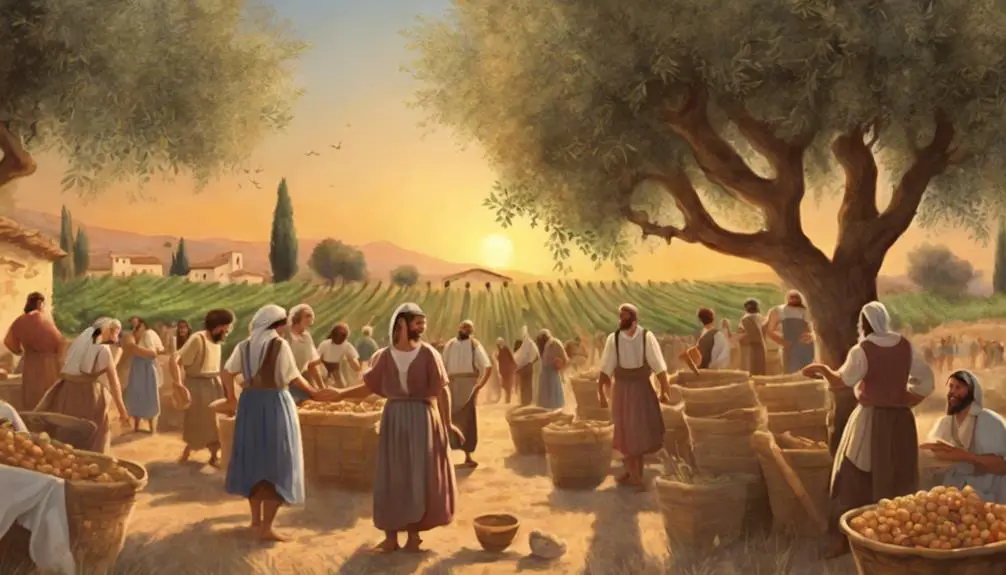
In biblical times, harvest festivals weren't merely occasions for celebration but also deeply symbolic events that reflected the community's gratitude towards God for the season's bounty. These gatherings were imbued with cultural significance, serving as a vibrant testament to the community's reliance on, and reverence for, the natural cycles that governed their lives.
Analyzing these celebrations reveals a tapestry of seasonal rituals that not only marked the passage of time but also reinforced the spiritual and societal bonds within these ancient communities. Here are three critical aspects that made these festivals stand out:
- Community Unity: Harvest festivals acted as a communal heartbeat, bringing everyone together in a shared purpose and celebration. This unity was a cornerstone of societal stability and mutual support.
- Gratitude and Offerings: They were a time for expressing gratitude to God, often through offerings and sacrifices. This practice highlighted a deep acknowledgment of the divine as the ultimate source of all sustenance.
- Seasonal Markers: These festivals served as significant markers of the agricultural calendar, guiding farming activities and ensuring that the rhythms of planting, tending, and harvesting were closely followed.
Understanding these elements sheds light on the profound relationship between the biblical communities and their environment, underscoring the timeless relevance of these ancient celebrations.
Frequently Asked Questions
How Did Environmental Conditions and Geography Influence the Types of Farming Practices Adopted in Biblical Times?
You're looking at how environmental conditions and geography shaped farming practices, right?
Climate adaptation and water management were crucial. Farmers had to analyze their surroundings closely to decide what to grow and how. Arid lands demanded innovative irrigation techniques, while fertile areas might focus on crops that thrived in those conditions.
It wasn't just about planting seeds; it was about understanding the land, weather patterns, and how to make the most of available resources.
What Was the Role of Livestock and Animal Husbandry in Biblical Narratives Outside of Agricultural Contexts?
In biblical narratives, livestock and animal husbandry played crucial roles beyond farming. They were integral to sacrificial rituals, symbolizing atonement and devotion. Animals also embodied prophetic symbolism, representing divine messages or judgments.
This usage reflected deep cultural and religious significance, highlighting animals' roles in conveying spiritual truths and societal norms. Thus, their presence transcended mere agricultural utility, embedding them into the fabric of spiritual and communal life.
How Did Farming Technology and Techniques Evolve Throughout the Periods Covered in the Bible, and Are There Any Specific Innovations Mentioned?
You're exploring how farming evolved over time, focusing on plow innovation and irrigation methods.
Initially, plowing was simple, but as time progressed, innovations made it more efficient, allowing for deeper soil turnover.
Similarly, irrigation methods advanced from basic water channeling to more sophisticated systems, ensuring crops received adequate water.
These advancements significantly boosted agricultural productivity, reflecting the era's technological progress and its impact on farming practices.
Are There Any References to Pest Control and Crop Diseases in Biblical Texts, and How Did These Challenges Impact Agricultural Productivity?
You're diving into how pest control and crop diseases are referenced in historical texts, focusing on their impact on agricultural productivity. These references aren't just literal; they often carry layers of pest interpretation and disease symbolism, offering insights into the challenges faced by ancient farmers.
Analyzing these texts, you'll find detailed descriptions and contextual analysis, shedding light on the evolving strategies used to combat these agricultural threats and their broader implications.
How Did Trade and the Exchange of Agricultural Goods With Neighboring Regions Affect the Economy and Social Structures in Biblical Times?
In ancient times, trade and the exchange of agricultural goods with neighboring regions significantly influenced both the economy and social structures. This trade diplomacy fostered alliances, broadened markets, and introduced new crops, enhancing food security and economic prosperity.
However, it also led to social stratification, as those controlling the trade amassed wealth and power, creating a divide between them and the less affluent, impacting the societal hierarchy and dynamics greatly.
Conclusion
In exploring the biblical landscape, you've journeyed from Eden's first garden to the complex agricultural systems of Canaan, uncovering the profound role farms played in ancient societies.
Through Jesus' parables, you've seen how farming transcended mere cultivation, embodying spiritual and moral lessons.
The intricate agricultural laws and vibrant harvest festivals further highlight how deeply farming was woven into the fabric of life, illustrating its significance not just as a means of sustenance but as a cornerstone of community and faith.

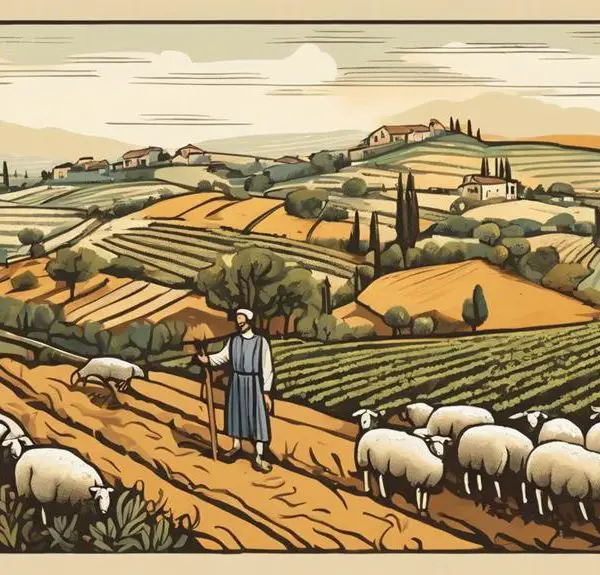

Sign up